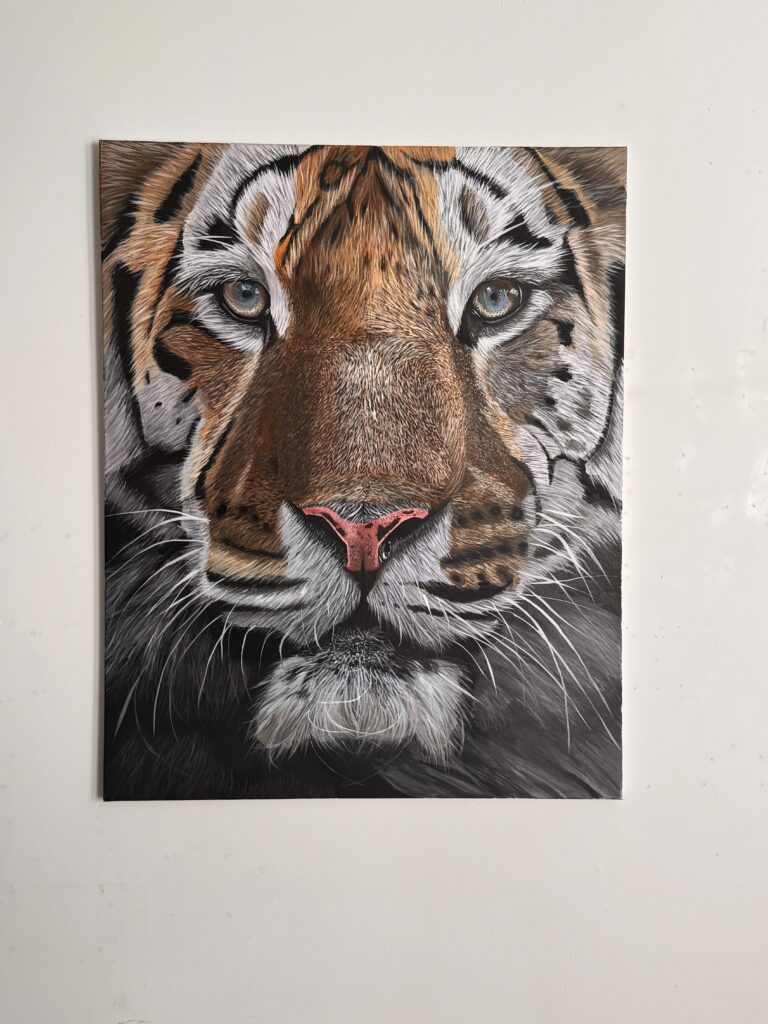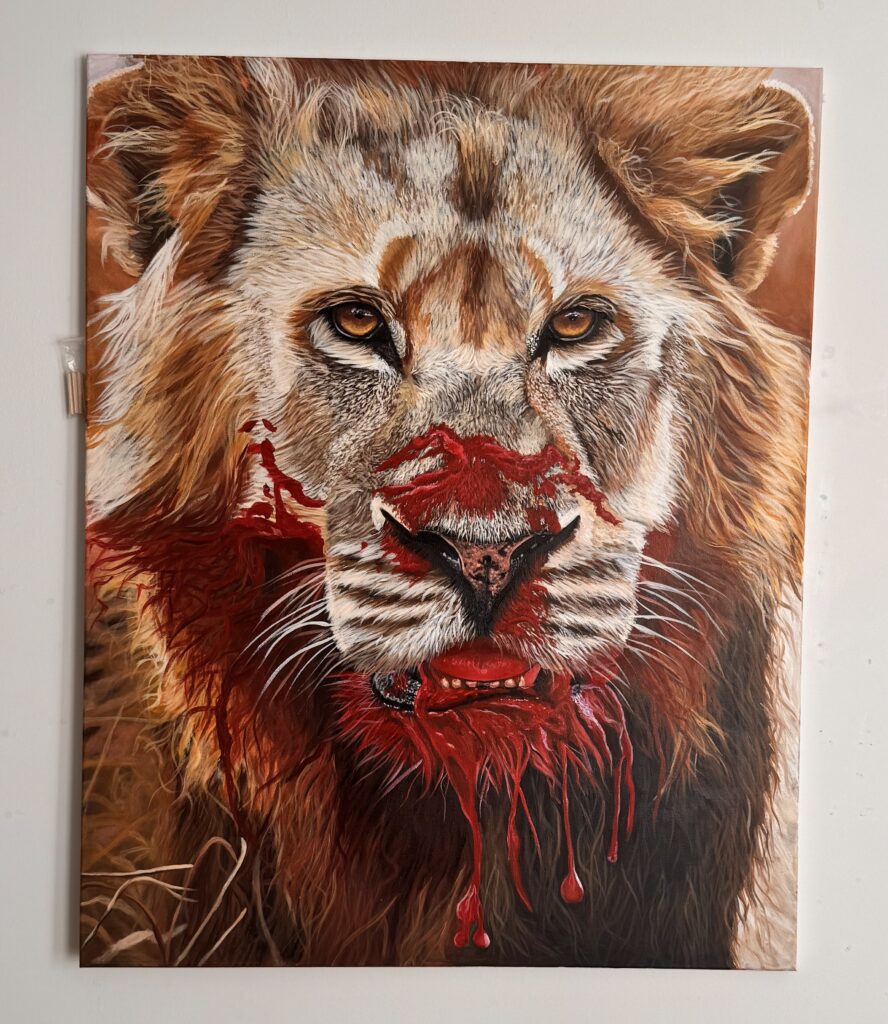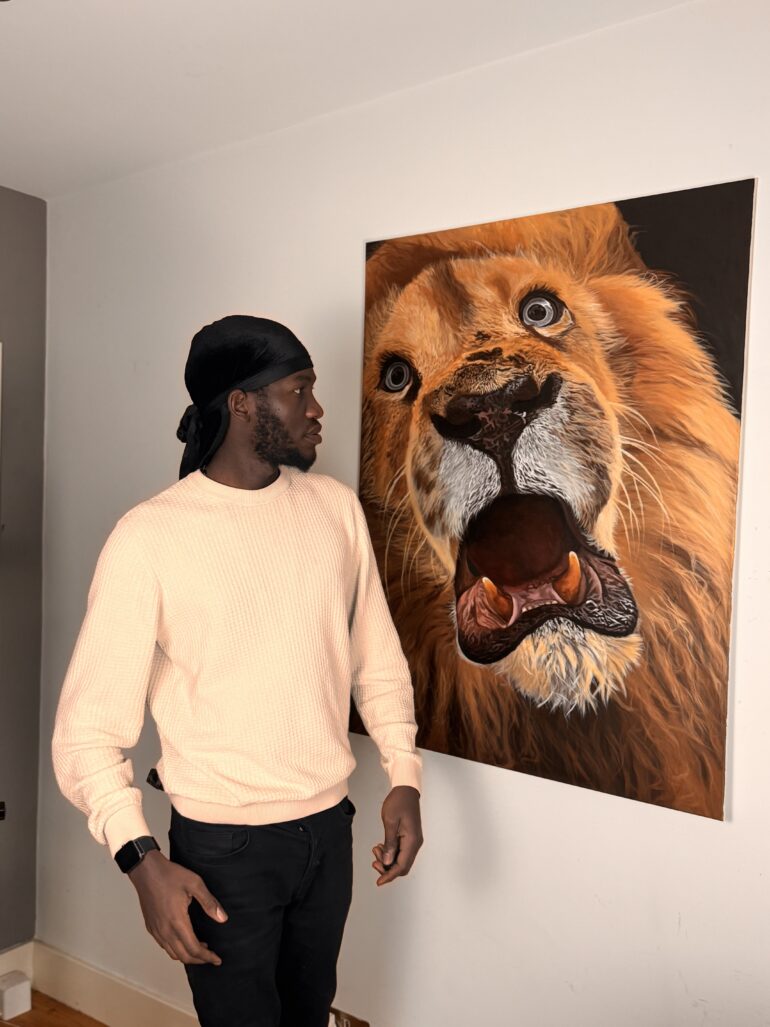Emerging Artist Series
In the latest edition of Culturalee’s Emerging Artist interview series we speak with Nigerian-born, UK-based artist Nedum Udeze, whose striking hyperrealistic wildlife paintings are more than mere representations of nature–they are visceral testaments to identity, endurance, and ancestral memory. Rooted deeply in his Nigerian and Igbo heritage, Udeze’s art transforms animals like lions and tigers into powerful metaphors for survival, freedom, and the silent resilience of a people who have endured war, genocide, and marginalisation.
His technique, though grounded in realism, moves beyond visual perfection. With painstaking layers, sharp detailing, and high-contrast depth, Udeze seeks not just to depict what is seen–but to reveal the unseen: the spirit, the pain, and the hope buried beneath the surface. Every brushstroke is a dialogue between past and present, between heritage and humanity.
As we explore his creative journey, Udeze shares how his personal struggles and triumphs mirror those of his painted subjects. This conversation is not just about art; it’s about legacy, survival, and the unyielding roar of identity that refuses to be silenced.

Your work is rooted in realism and wildlife art, yet deeply influenced by your Nigerian heritage. How does your cultural background shape the subjects, symbolism, or techniques in your paintings?
My work is deeply tied to my Igbo heritage. The history of my people, our struggles, our survival, and our resilience, shapes the way I see my subjects. The animals I paint are not ornaments; they are metaphors for identity, endurance, and freedom. The lion’s roar carries echoes of ancestral strength, while the tiger’s stare mirrors silent resilience.
My techniques are also influenced by this heritage. I work in hyperrealism, but not for perfection’s sake. I build fine layers, use sharp detailing, and play with deep contrasts of light and shadow to move beyond surface likeness into emotion. I paint what is not seen: the spirit, the pain, and the resilience hidden beneath. In this way, my cultural background doesn’t just guide what I paint, it shapes how I paint, turning realism into a vessel for memory and storytelling.
Much of your work explores themes of resilience and identity. Can you share how your personal journey—from Nigeria to being based in the UK—has shaped these themes in your art?
Resilience is the thread of my life and my art. Growing up in Nigeria, I carried the legacy of a people who endured war, genocide, and marginalisation. That weight shaped how I see myself and the world. When I moved to the UK, those memories did not leave me, they became the inner fire that drives me to keep painting.
Every brushstroke is a dialogue between past and present: the struggles of my ancestors, my own survival, and the fight for freedom and dignity that continues today. My journey, balancing years of physically demanding jobs with the pursuit of my art, mirrors the resilience I paint in lions, and tigers. They embody survival against all odds, just as my people and I have had to. In this way, my art is both personal and universal, it is about endurance, memory, and the unyielding hope of freedom.

What is your creative process like when beginning a new painting?
My creative process begins with emotion. Most times, I find it through live videos of wildlife, moments where the raw spirit of lions, tigers, or other animals reveals itself. When I see a reflection of myself in their gaze or movement, I immediately connect and capture it. I don’t just paint any lion or tiger I come across; I seek that spiritual moment where their soul aligns with mine, carrying echoes of my ancestors, my heritage, and who I am.
At the conceptual stage, I am not painting the visible surface but what is unseen, the transformation of their lived experience into a deeper story. The process often feels chaotic: when I begin, the work can look like nothing, even rubbish. Yet, I trust the flow, because with persistence, the truth of the painting emerges. It becomes a spiritual metamorphosis, a bridge between resilience, identity, and the silent voices of nature.
My personal journey to the UK has shaped this process too. Years of resilience, balancing physically demanding jobs with my art, have taught me endurance. That struggle mirrors what I see in my subjects: survival, power, and hope. Every stroke becomes both personal and universal, carrying the weight of my story and the voice of those who came before me.
Your work often highlights the human connection with nature. What message do you hope to convey through this relationship—particularly in the context of environmentalism and global ecological awareness?
For me, wildlife is not separate from humanity, it is a reflection of who we are. When I paint, I want to remind people that the survival of these animals mirrors our own survival as a species. We share a fragile, interconnected world. My message is about reverence and responsibility: to see the lion’s roar as our own cry for balance, to see the tiger’s gaze as a reminder of our own vulnerability. In an age of environmental crisis, I want my work to stir empathy and awaken a consciousness that protecting nature is protecting ourselves.
Are there particular Nigerian artists or other global figures in art who have influenced your style or artistic philosophy? How have they helped shape your creative identity?
Yes, several artists have been pivotal in shaping my journey. The first time I encountered Kelvin Okafor’s hyperrealistic drawings on social media, I was overwhelmed. At that time, I was still searching for my niche using charcoal pencils. His mastery and technique made me question myself: why draw again when someone has already reached such perfection? But that moment of doubt became a turning point. Instead of giving up, I channelled my energy into finding my own path, one that would challenge me to rise to the task ahead.
Later, I discovered Nick Sider, whose wildlife paintings inspired me to explore animals as a central theme. His ability to capture their intensity and presence resonated deeply with my own passion for storytelling through wildlife. And when I moved to the UK, I came across Richard Whittlestone, who has been painting since 1978. His profound connection between art and the environment, and the stories behind his work, gave me another layer of inspiration. These artists remind me that influence is not about imitation but about finding courage and clarity in one’s own voice.
You’ve exhibited at notable galleries including The Holy Art in London and Paris, Boomer Gallery, and Magan Gallery. How have these experiences influenced your growth as an artist and your connection with a broader, international audience?
Exhibiting at international galleries has been transformative. Each show has allowed me to place my story and vision within a global context, to see how audiences from different cultures respond to themes of resilience, heritage, and wildlife. The Holy Art, Boomer Gallery, Magan Gallery and others gave me not just visibility but also validation that my work carries universal relevance. It has expanded my audience beyond Nigeria and the UK, and has shown me that the struggles, survival, and hope I portray are not limited to one culture, they are shared human experiences.
In a world that often feels disconnected—from each other and from nature—what role do you see art playing in healing, conversation, and reconnection? What do you hope viewers take away from engaging with your work?
I believe art carries the power to heal the fractures within us and between us. For me, painting is not only about wildlife or beauty, it is about memory, truth, and freedom. My work is rooted in the fire of my ancestors, whose voices were silenced by war, genocide, and marginalisation. That weight lives on, generation after generation, and through my art I want to make sure it is not forgotten.
I want the world to know that the aftermath of war does not end when the fighting stops; it echoes for generations. Children yet unborn inherit that history. Through my art, I channel this ancestral fire into a language the world can see and feel, reminding us that freedom is not just a hope, but a responsibility.
When I paint a lion or tiger, I am not just painting an animal; I am painting resilience, survival, and the cry for freedom that my people carried, and that all humanity shares. In a disconnected world, art becomes a bridge. It can remind us of our shared vulnerability, our responsibility to nature, and our duty to each other.
I also want people to find strength in my paintings. Whatever challenge life brings, keep fighting and never give up. Just like the lion, it does not always win, but it never gives up, because giving up means death. And like the tiger, it never cries, it stares, it endures.
What I hope viewers take from my work is more than admiration, it is a deeper awareness. I want them to feel the soul of the subject, to sense the echoes of history, and to walk away with a reminder that freedom, survival, and resilience are not abstract ideas. They are lived realities, and we must protect them for ourselves, and for the generations yet to come.
Find out more about the art of Nedum Udeze here.



